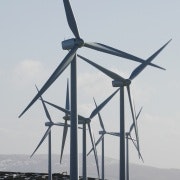The wind beneath the turbines
In a somewhat surprising new discovery, researchers from the Rensselaer Polytechnic Institute’s Department of Mathematical Sciences have found that changes in air flow patterns within wind turbine arrays can occur that result in wind energy becoming available from a rather unexpected direction – from below.
The finding was made while the researchers were modeling how variations in air flow patterns affect the output power of wind turbines – work which was being done to remedy the fact that most wind turbine array studies have overlooked the fact that important airflow changes occur inside the array, according to the researchers.
Experimental 'isocontours' data show the mean streamwise velocity along the center line of a scaled wind turbine array

Source: J.Newman/RPI
“We discovered that a typical measure of the significance of flow changes was rather deficient,” states Jensen Newman, co-author of the new paper and a graduate student at Rensselaer Polytechnic Institute’s Department of Mathematical Sciences.
“Inspired by a desire to describe the flow experienced by realistic wind turbine arrays in greater detail, the team created a model of how flow affects wind turbines’ output power.”
The new model provides a more considerably more accurate representation of the magnitude of the changes that occur than previous models have. “It shows that in addition to energy being made available to the turbines from above, energy is also transferred from below,” Newman explains.
The American Institute of Physics provides more:
The researchers are now planning to continue this line of investigation by expanding the scope of the research:
“We’ll apply this analysis to the case of two-bladed versus three-bladed turbines to identify the critical differences in flow patterns and how these affect turbine power production,” Newman states.
“Similar analysis will be performed using much larger turbines to examine how the physics discovered here scale with turbine size so that the extrapolation of the results to full-scale wind farms can be better understood.”
The new findings were detailed in a paper just published in the journal Physics of Fluids.
Originally published on CleanTechnica. Republished with permission.
















